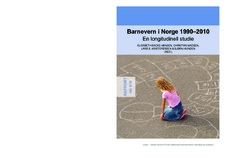| dc.description.abstract | In this report new results from the study ”Child welfare in Norway 1990-2010” are presented. The project started in the middle 1990’ies, and since then new cohorts have been added consequtively. By 2010 the child welfare sample consisted of just below 170000 persons aged 0 to 43 who were recipients of child welfare and child protection measures between 1990 and 2010. A representative comparison sample without child welfare experience consisting of just below 180000 persons was added. The analyses presented in this resort are based on various research issues arising from this data base. For both samples it has been possible to combine administrative data at the individual level from Statistics Norway (for instance social benefits, educations, and reasons for dying). In addition we have, for the first time, been able to follow three cohorts of children and young people from birth to 18-20 and their contact with the child welfare services. Altogether a very rich source of knowledge is thus made available about an important welfare service. Much resesarch has been done about young adults with child welfare experiences during the last two or three decades. The results point fairly unequivocally to a high risk of marginalization in several important life areas. As well the young adults face an increased risk of mental health problems and other life problems. Analyses of how many who at least finished high school, had an average years income, and who had not received social assistance or been unemployed during certain periods, showed that those without child welfare experiences were far more likely to have achieved these goals. The numbers with disability pension were higher among the child welfare sample, as were mortality rates. However, when we looked at outcomes for the same young adults four years later, the rate achieving positive transitions had almost doubled. This result is promising. Young adults who achieved positive transitions in the way defined here were to a larger degree female, had more often received aftercare services, and more often been in foster care as opposed to remaining at home with preventive services or been primarily in residential care. In addition slightly more young adults with immigrant backgrounds did well than the Norwegian-born, which is probably related to the fact that more from the latter group received services because of severe behavior problems or drug problems. Besides those with disabilities, these two groups were those least likely to achieve good transitions. This is important, particularly because there will always be a selection process to the child welfare services for many different reasons and with varying risk factors directly associated with the children and young people. Over time further selection processes will take place where up to 30 per cent of each cohort may be placed looked after outside their homes for shorter or longer periods of time. Often the looked-after children will have been exposed to more risk factors and themselves be more troubled than those remaining at home. In addition young adults with child welfare experiences will usually have grown up in families where different marginalization processes are heavily involved. Their parents usually have a lower educational attainment than usual in today’s society, and consequently face more obstacles when it comes to achieving stable employment. This again increases the probability of more continuous dependence on transfers from the social services. These problems are then aggravated by an increased risk of various health problems as well as higher mortality rates. How the young adults fare as grown-ups will, then, depend on their situation before they came into contact with the child welfare services, the conditions they have been offered after this, particularly in the case of out-of-home placement, the after-care services they have received and last, but not least, how they have comprehended and related to their life situation while growing up. The report concludes with a series of suggestions about further research, pertaining to further longitudinal analyses of the child welfare sample as well as in-depth analyses of more specific issues of importance. | en |
| dc.description.abstract | I denne rapporten presenteres resultater fra prosjektet «Barnevern i Norge 1990–2010». Vi spør hvordan det går med unge voksne med barnevernserfaring: Får de til gode overganger til voksenlivet i form av utdanning og arbeid? Hovedsvaret er at mange får det, særlig når de får ekstra tid på seg. Dette er oppmuntrende, selv om langt flere unge voksne uten barnevernserfaring oppnår slike gode overganger. Resultatene viser at det er av betydning for videre livsløp hvorfor det i sin tid ble iverksatt barnevernstiltak, eller hva slags tiltak de unge voksne har mottatt. Videre om de er kvinner eller menn, om de har fått ettervern, eller om de har innvandrerbakgrunn. Rapporten viser klart hvor viktig det er å følge barn og unge med barnevernserfaring over mange år. Barne-, ungdoms- og familiedirektoratet har finansiert prosjektet. | no_NB |
